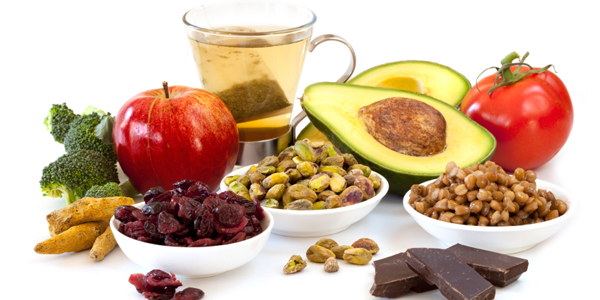Inflammation is your body’s defensive reaction to injury, infection or damaged tissue, which helps to destroy, remove or separate the injured tissue and the virus from the rest of the body. This process of acute inflammation usually causes pain, heat, and redness.

A healthy diet is one way to fight inflammation.
Acute inflammation is a natural response. When infection or damaged tissue needs to be removed or blocked off, the immune system responds by sending white blood cells to protect the body. These cells carry a chemical that, when leaked, may cause swelling. The area where the tissue is being removed becomes heated and often painful. If the infection is close to the skin, the area may also become red and swollen. Usually, after the white blood cells have minimized the threat, the body will send anti-inflammatory compounds in order to neutralize the symptoms and start the healing process. This balance of inflammation and healing is normally the sign of a healthy immune system.
However, in some cases, this system gets out of control. Although there may no longer be no imminent threat in the body, the immune system refuses to stop sending white blood cells, even attacking healthy parts of the body. This causes continuous inflammation that shows no signs of receding. According to Marcelle Pick, co-founder of Women to Women Clinic, this is a warning that “the “on” switch to your immune system is stuck.” It’s when this happens that inflammation begins to become a problem. Since the immune system is most active in the digestive tract, dutifully preventing bacteria and viruses in food from infecting your body, it is often, but not always, this part of the body where it loses control and inflammation begins. Some early signs of intestinal inflammation include intestinal bloating, frequent diarrhea, constipation, gas, pain, heartburn and acid reflux. From here, the inflammation can become chronic, and slowly spread around the body, causing unpleasant symptoms and eventually leading to various serious health problems.
The earliest, and most common symptoms of inflammation include pain, heat, redness, swelling, throbbing and irritation. The sensation of inflammation is often described as “burning from the inside.” Eventually, symptoms such as shortness of breath, body aches and pains, congestion, frequent infections, diarrhea, dry eyes, indigestion, shortness of breath, skin outbreaks, swelling, stiffness and weight gain, and eventual obesity. Chronic inflammation also gives way to more serious ailments such as arthritis, which is the inflaming of the joints, or asthma and osteoporosis.
One of the most prominent factors in causing, but also lessening, inflammation is diet. A high carbohydrate diet with little protein is very conducive to inflammation, while fruits, vegetables, antioxidants and 6-8 glasses of water a day can help to lessen the effects. For more information on reducing inflammation through food see Marcelle Pick’s Anti-inflammatory Diet and Comfort Life’s “Fighting Inflammation with Food.”
As it lies at the root of many degenerative diseases, it is important to notice chronic inflammation when it begins, and listen to your body in order to keep it healthy. Remember that making the appropriate lifestyle choices and changing your diet can go a long way to making sure inflammation doesn’t get the better of you and your body.
* * * * *
What are your secrets for living a healthy lifestyle? Share your thoughts in the Comments section below.
Related:
